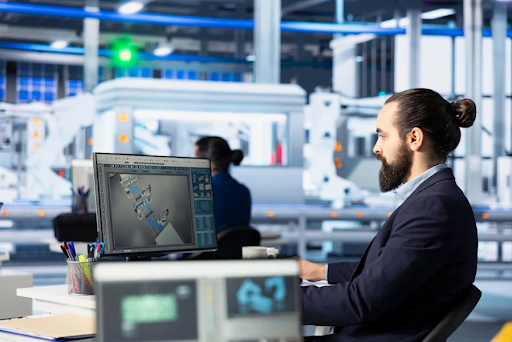Manufacturing continues to change at lightning speed, and CNC machined components are leading the charge. With industries like aerospace, automotive, energy, and medical devices requiring more complex, precision components, the CNC machining industry is meeting the challenge through innovation, automation, and environmental stewardship. In 2025, the emphasis is no longer on efficiency and precision alone but also on smart, adaptive, and environmentally responsible manufacturing systems. Let’s explore the key trends shaping the future of CNC machining this year.
1. Smart Manufacturing and Industry 4.0 Integration
By 2025, Industry 4.0 technologies will be mainstream in CNC machining, and integration is a characteristic trend. Current CNC systems come with IoT connectivity, allowing real-time data capture from sensors, machines, and tools. Performance can now be monitored, maintenance anticipated, and machining parameters optimized by advanced analytics for manufacturers.
This digital revolution makes processes more efficient, eliminates downtime, and produces consistent quality. Intelligent factories employ networked CNC machines that interact and adjust autonomously to retain accuracy. This move towards data-driven decision-making is making production lines more responsive and agile than ever.
2. AI and Machine Learning in CNC Machining
Machine Learning (ML) and Artificial Intelligence (AI) are transforming the production of CNC machined components. Machining data is now inspected by AI algorithms to maximize tool path optimization, anticipate tool wear, and enhance the accuracy of parts. ML models assist manufacturers in optimizing cutting speed, feed, and cooling to increase tool life and minimize energy consumption.
In 2025, AI-based machines can even sense minute differences in the properties of materials and adjust machining settings automatically, cutting waste and improving reliability. This smart automation not only enhances quality but also reduces manual intervention, opening the door to more intelligent, self-regulating production environments.
3. Multi-Axis and Hybrid Machining Supremacy
Multi-axis milling, especially 5-axis and hybrid machines, remains the reigning horse in CNC. Such machines enable the machining of extremely intricate geometries in one setup, significantly cutting down on errors and cycle times.
Hybrid technologies, which integrate additive (3D printing) and subtractive (machining) processes, are increasingly becoming popular to fabricate parts with complex internal geometries and close tolerances. This trend is notably strong in aerospace and medical industries, where accuracy, weight savings, and surface integrity are of utmost importance.
By integrating various technologies, designers and manufacturers are now able to gain increased design flexibility and reduced lead times without compromising the integrity and performance of CNC machined components.
4. Eco-Friendly and Sustainable Manufacturing
Sustainability is now at the core of manufacturers’ agendas in 2025. CNC machining traditionally requires much material, but advances in cutting fluid management, recycling, and energy efficiency are reversing that.
Manufacturers increasingly use dry machining, minimum quantity lubrication (MQL), and sophisticated coolant filtration systems to reduce environmental footprint. In addition, CNC machines equipped with energy-efficient motors and intelligent power management systems lower electricity usage.
Material optimization software also provides minimal waste during manufacturing, enabling manufacturers to achieve world sustainability targets without sacrificing profitability.
5. Digital Twins and Simulation Technology
Digital twin technology is changing the planning and execution of CNC processes. A digital twin refers to a virtual representation of the physical machining environment that replicates real-world conditions. Engineers can now simulate the machining process, validate tool paths, and detect potential problems prior to actual production.
In 2025, the technology will become mainstream in high-precision industries, making manufacturing less expensive for prototyping, more precise, and faster with time-to-market. When integrated with AI and IoT, digital twins provide real-time feedback that allows continuous process optimization.
6. Innovations in Advanced Materials and Tooling
As industries extend the performance frontier, the need for high-performance materials like titanium alloys, Inconel, and carbon fiber composites grows. Machining these materials demands specialized tools with greater hardness, coatings, and wear resistance.
CNC tool makers are currently producing next-generation cutting tools from nanocomposite materials and ceramics. Diamond-like carbon (DLC) and titanium aluminum nitride (TiAlN) coatings additionally promote tool wear resistance and accuracy. The technologies allow smoother machining of hard-to-cut materials, improving tool life and surface quality.
7. Increased Customization and Small-Batch Production
The growth of customized products and reduced production runs has fueled the need for adaptive CNC machining solutions. High-speed automation, rapid change tooling, and adaptive programming allow small batches of customized parts to be made efficiently without sacrificing quality.
This change benefits industries such as aerospace, electric vehicles, and medical devices, where every project tends to need specialized CNC machined components with precise dimensions and tolerances. Quick reconfiguration of machines for other parts improves the responsiveness to customer orders and market conditions.
8. Quality Control and Automation Integration
Contemporary CNC machining is becoming increasingly automated with in-process quality inspection. High-speed sensors, laser scanners, and vision systems now check part accuracy in process dimensions instead of post-process.
This eliminates rejection and guarantees constant adherence to stringent industry standards. Automated inspection data is also input into AI systems for ongoing quality optimization. Precision is effectively being embedded into every phase of the machining process.
Conclusion
As we make our way through 2025, the CNC machining sector is welcoming an era of intelligence, sustainability, and connectivity. From AI-driven optimization to hybrid manufacturing and green innovations, every trend is pioneering what can be done with high-precision manufacturing.
At the core of this transformation is a commitment to quality, adaptability, and precision, values that continue to motivate leaders such as Gemsons Precision Engineering. Through the use of cutting-edge technology and four decades of experience, they continue to lead in the provision of high-quality CNC machined components to the aerospace, automotive, and industrial markets, as required by an ever-evolving global environment.



Recent Comments